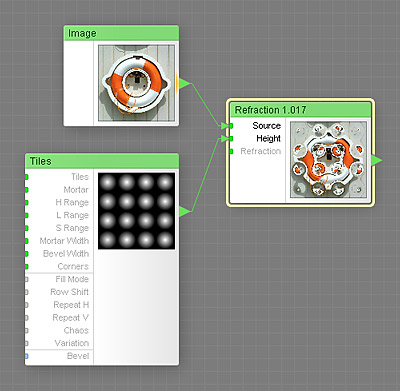
This component is obsolete and its use in filters is not recommended. Use the recent version of the component.
The Refraction component imitates an optical phenomenon when a ray of light changes its direction when passing through a boundary between materials with different refractive indices. The component 'places' the image supplied by the Source input underneath a refractive layer defined by the Height input and calculates the refraction according to the refractive index ratio specified by the Refraction parameter. This is a map component, it can be located in the Processing category on the Components Bar.
Provides the source image for refraction. The source image is 'placed' underneath the refractive layer, the thickness of which is defined by the Height input. Source is a required input – in order to make Refraction work, this input must be connected.
Defines the height of the refracting surface 'placed' over the Source image, or, in other words, the thickness of the refractive layer. The image supplied to this input is converted to grayscale by averaging its R, G and B channels, and the resulting grayscale image defines the height: black image areas correspond to the height of 0, white areas correspond to the height equal to the global Size value, and the heights in between are represented by intermediate levels of gray. Height is a required input – in order to make Refraction work, this input must be connected.
Refraction: Map Input
Defines the amount of refraction. Refraction of 0 produces no effect, and the value of 100 results in the maximum refraction. Since Refraction is a map input, its value can be controlled separately for different image areas by connecting a map component to this input.
Technically, this parameter defines the ratio of two refraction indices (IOR ratio): that of the surrounding medium (IOR1) to that of the refractive layer material (IOR2) according to the following equation: Refraction = 100 * (1 - IOR1 / IOR2). Note that this approach has a limitation: it does not allow you to define an IOR ratio greater than 1 (when a ray passes from a material with a higher IOR to a material with a lower IOR).